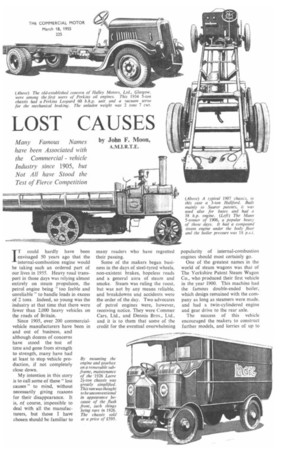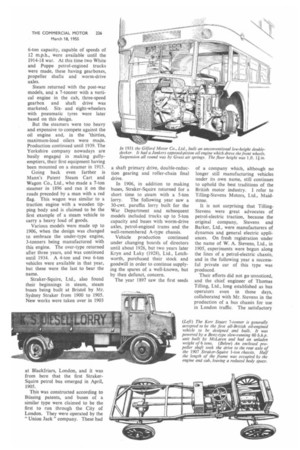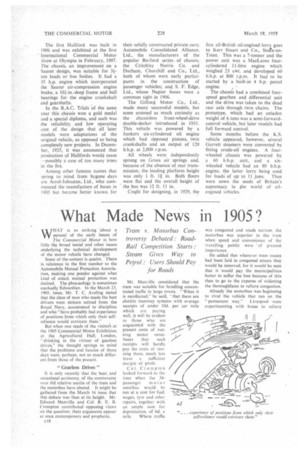LOST CAUSES
Page 141

Page 142

Page 149

Page 150

If you've noticed an error in this article please click here to report it so we can fix it.
Many Famous Names have been Associated with the Commercial vehicle Industry since 1905, but Not Al! have Stood the Test of Fierce Competition by John F. Moon,
A.M.I.R.T.E.
IT could hardly have been envisaged 50 years ago that the internal-combustion engine would be taking such an ordered part of our lives in 1955. Heavy road transport in those days was relying almost entirely on steam propulsion, the petrol engine being "too feeble and unreliable" to handle loads in excess of 2 tons. Indeed, so young was the industry at that time that there were fewer than 2,000 heavy vehicles on the roads of Britain.
Since 1905, over 200 commercialvehicle mannfacturers have been in and out of business, and although dozens of concerns have stood the test of time and gone from strength to strength, many have had at least to stop vehicle production, if not completely close down.
My intention in this story is to call some of these" lost causes" to mind, without necessarily giving reasons for their disappearance. It is, of course, impossible to deal with all the manufacturers, but those I have chosen should be familiar to many readers who have regretted their passing.
Some of the makers began business in the days of steel-tyred wheels, non-existent brakes, hopeless roads and a general aura of steam and smoke. Steam was ruling the roost, but was not by any means reliable, and breakdowns and accidents were the order of the day. Two advocates of petrol engines were, however, receiving notice. They were Cornmer Cars, Ltd., and Dennis Bros., Ltd., and it is to them that some of the credit for the eventual overwhelming popularity of internal-combustion engines should most certainly go.
One of the greatest names in the world of steam wagons was that of The Yorkshire Patent Steam Wagon Co., who produced their first vehicle in the year 1900. This machine had the famous double-ended boiler, which design remained with the company as long as steamers were made, and had a twin-cylindered engine and gear drive to the rear axle.
The success of this vehicle encouraged the makers to construct further models, and lorries of up to 6-ton capacity, capable of speeds of 12 m.p.h., were available until the 1914-18 war. At this time two White and Poppe petrol-engined trucks were made, these having gearboxes, propeller shafts and worm-drive axles.
Steam returned with the post-war models, and a 7-tonner with a verti cal engine in the cab, three-speed gearbox and shaft drive was marketed. Sixand eight-wheelers with pneumatic tyres were later based on this design.
But the steamers were too heavy and expensive to compete against the oil engine and, in the 'thirties, maximum-load oilers were made. Production continued until 1939. The Yorkshire company nowadays are busily engaged in making gullyemptiers, their first equipment having been mounted on a steamer in 1915.
Going back even farther is Mann's Patent Steam Cart and Wagon Co., Ltd., who made a 7-ton steamer in 1896 and ran it on the roads preceded by a man with a red flag. This wagon was similar to a traction engine with a wooden tipping body and is claimed to be the first example of a steam vehicle to carry a heavy load of goods.
Various models were made up to 1906, when the design was changed to embrace the under-type engine, 3-tonners being manufactured with this engine. The over-type returned after three years, and was continued until 1934. A 4-ton and two 6-ton vehicles were available in that year, but these were the last to bear the name.
Straker-Squire, Ltd., also found their beginnings in steam, steam buses being built at Bristol by Mr. Sydney Straker from 1900 to 1905. New works were taken over in 1903 a shaft primary drive, double-reduction gearing and roller-chain final drive.
In 1906, in addition to making buses, Straker-Squire returned for a short time to steam with a 5-ton lorry. The following year saw a 30-cwt. paraffin lorry built for the War Department and subsequent models included trucks up to 5-ton capacity and buses with worm-drive axles, petrol-engined trams and the well-remembered A-type chassis.
Vehicle production continued under changing boards of directors until about 1926, but two years later Kryn and Laky (1928), Ltd., Letchworth, purchased their stock and goodwill in order to continue supplying the spares of a well-known, but by then defunct, concern.
The year 1897 saw the first seeds of a company which, although no longer still manufacturing vehicles under its own name, still continues to uphold the best traditions of the British motor industry. I refer to Tilling-Stevens Motors, Ltd., Maidstone.
It is not surprising that TillingStevens were great advocates of petrol-electric traction, because the original company, Stevens and Barker, Ltd., were manufacturers of dynamos and general electric appliances. On fresh registration under the name of W. A, Stevens, Ltd., in 1905, experiments were begun along the lines of a petrol-electric chassis, and in the following year a successful private car of this type was produced.
Their efforts did not go unnoticed, and the chief engineer of Thomas Tilling, Ltd., long established as bus operators even in those days, collaborated with Mr. Stevens in the production of a bus chassis for use in London traffic. The satisfactory completion of, this bus 'pointed the way to future produetion of petrolelectric vehicles and the formation of Tilling-Stevens, Ltd.
In addition to the bus chassis. two goods chassis of 2i-ton and 4-ton capacity were also marketed and a steady expansion of the range later included gear-driven vehicles and troileybuses. The use of oil engines was started during the 1930s, and more than a little excitement was caused at the 1937 Commercial Motor Show by the appearance of the Successor passenger chassis.
This was a six-wheeler with independent suspension for the rear bogie, and the power unit was a horizontally opposed eight-cylindered oil engine, driving through a May nach seven-speed pre-selector gearbox. In many respects the herald of the type of coach chassis so common on the roads today, the Successor must have appeared too revolutionary, for little has been heard of it since its inception.
The company took over the Vulcan Motor and Engineering Co., Southport, in 1938 and was itself taken over by the Rootes Group in 1951, when vehicle production ceased. Nowadays the Maidstone factory produces the Commer TS3 oil engine. component parts for military vehicles and reconditioned engines for the whole group.
A similar fate to that of TillingStevens befell Halley's Industrial Motors, Ltd., which for 34 years produced goods vehicles with a reputation for tough and robust con struction. The Halley works at Yoker, Glasgow, are now occupied by Albion Motors, Ltd., another pioneer in the industry, and there much of the component manufacture for current Albion models is done. Halley's, who were formed in 1901 to manufacture steam wagons, started life under the name of the Glasgow Motor Lorry Co., Ltd., and assumed their final title in July, 1906, soon after the first petrol-engined vehicles were produced in response to a large public demand.
Until the 1907 R.A.C. Commercial Vehicle Trials took place, the Halley was little known outside Scotland, but the award of gold and silver medals at the trials resulted in a flood of orders from England and overseas. Rapid expansion of the Yoker works ensued and 2-ton, 3-ton, 5-ton and 7-ton chassis were produced in increasing numbers. With the exception of one 30-cwt. vehicle which had a worm-drive axle, all
these chassis had chain drive. _Fourcylindered engines were fitted to all except the 7-tonner, which had a sixcylindered unit.
These models continued until the outbreak of the 1914-18 war, but in 1919 a 3-tonner with worm-drive axle appeared, to be followed in 1921 by a 2-tonner and 21-tonner with similar transmission. In 1923, several types of chassis were made specifically for fire-engine use, a line which persisted strongly to the end, passenger chassis also appeared.
Halley's were among the original users of Perkins oil engines, a 41--ton chassis being produced in 1934 which had a Perkins Leopard 60 b.h.p. power unit and vacuum-servo braking. The 4-tonner weighed under 3 tons in taxation condition and sold for £695, a competitive figure in those days. A deflationary policy, which was forcing customers to cancel important orders, was, however, causing heavy financial loss to Halley's, and in September, 1935, the company were wound up. Lacre Lorries, Ltd., Welwyn Garden City, nowadays well known , for their products in the municipal field, also have long-established associations with the industry. Originally formed in January, 1902, in the name of the Long Acre Motor Car Co., Ltd., the first two words of the title were, a few months later.contracted to read "Lacre," and this name remains today.
In addition to being the English distributors of Albion vehicles, Lacre also marketed vehicles under their own name, concentrating on light delivery vans. Once the initial opposition from the large stores had been overcome, orders began to pour in for the 25-cwt. 16 h.p. chassis. and in 1909 a works was built at Letchworth and production of a range from 10 cwt. to 5 tons was
commenced. It was around this Lime that the first road sweepers were made and Glasgow Corporation were quick to realize the advantages of the Lacre sweeper and placed an order for several,
Economical 2-ton Chassis Various experiments had proved that a 25-cwt. chassis loaded to capacity was Id. a mile less expensive to operate than a 2-ton chassis fully laden, whilst the 2-ton chassis was no more expensive to run than a 25-cwt. model when only carrying 25 cwt., and this led to the largescale production of 2-ton and 21-ton chassis by Lacre. Many hundreds of these vehicles were in service with the Armed Forces during the 1914-18 war, and production continued at an increased rate after the war.
In 1926 a forward-control 24-ton chassis was produced. This had a full front, which was considered out of the ordinary in those days, and a sub-frame mounting for the engine, radiator and petrol tank, which was easily detachable for maintenance.
The business was offered for sale in January, 1928, and in February of the same year the present company of Lacre Lorries, Ltd., was formed. Production of 2i-ton chassis continued until 1938, but the roadsweeper line was proving profitable and this has been concentrated on since the last war.
in 1785 John Hall founded an iron company and two years later the Dartford Ironworks were built. The production of J. and E. Half, Ltd., has varied from beam-type steam engines in 1836 to modern electric lifts and refrigerators in 1955, but for about 20 years a reliable and well-known commercial vehicle. the Hallford, figured prominently in their order books, The first Hanford was built in 1906 and was exhibited at the first International Commercial Motor Show at Olympia in February, 1907. fhe chassis, an improvement on a Saurer design, was suitable for 3ton loads or bus bodies. It had a 35 h.p. engine which incorporated the Saurer air-compression engine brake, a 101-in.-deep frame and ball bearings for the engine crankshaft and gearshafts.
In the R.A.C. Trials of the same year this chassis won a gold medal and a special diploma, and such was the reliability, and low operating cost of the design that all later models were adaptations of the original vehicle, as opposed to• being completely new projects. In December, 1925, it was announced that production of Halliards would cease —possibly a case of. too many irons in the fire.
Among other famous names that spring to mind from bygone days are Arrol-Johnston,. Ltd., who commenced the manufacture of buses in 1905 but became better known for their solidly constructed private cars; Automobile Consolidated Alliance, Ltd., the manufacturers of the popular Burford series of chassis; the Critchley Norris Co. and Durham, Churchill and Co., Ltd., both of whom were early participants in the construction of passenger vehicles; and S. F. Edge, Ltd., whose Napier buses were a common sight in 1906.
The Gilford Motor Co., Ltd., made many successful models, but none aroused as much curiosity as the chassisless front-wheel-drive double-decker introduced in 1931. This vehicle was powered by a Junkers six-cylindered oil engine which had opposed pistons, twin crankshafts and an output of 120 b.h.p. at 2,000 r.p.m.
All wheels were independently sprung on Gruss air springs and, because of the absence of rear transmission, the loading platform height was only 1 ft. in. Both floors were flat and the overall height of the bus was 12 ft. 11 in.
Credit for designing, in 1929, the first all-British oil-engined lorry goes to Kerr Stuart and Co., Store-onTrent. This was a 7-tonner and the power unit was a MacLaren fourcylindered 11-litre engine which weighed 23 cwt. and developed 60 b.h.p. at 800 r.p.m. It had to be started by a built-in 4 h.p. petrol engine.
The chassis had a combined fourspeed gearbox and differential unit and the drive was taken to the dead rear axle through twin chains. The prototype, which had an unladen weight of 6 tons was a semi-forwardcontrol vehicle, but later models had full forward control.
Some months before the K.S. vehicle appeared, however, several Garrett steamers were converted by fitting crude-oil engines. A fourwheeled ,chassis was powered by a 60 b.h.p. unit, and a sixwheeled vehicle had an 80 b.h.p. engine, the latter lorry being used for loads of up to 11 _tons. Thus were sown the seeds of Britain's supremacy in ,he world of oilengined vehicles.








































































































































































































































































